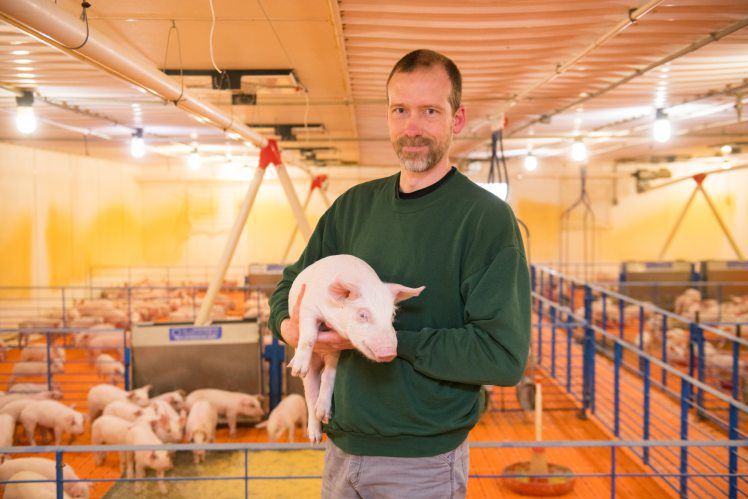Did you know that the average American consumes about 50 pounds of pork per year? We enjoy bacon, sausage links, ribs, chops, shoulder, ham, steak and more. Touted as “the other white meat,” pork is healthy and easy to prepare.
No. 1 Pork Producer
Iowa is the No. 1 pork producer in the nation. According to 2019 statistics provided by the IPPA, there are 6,200 pig farms in Iowa and at any one time there are approximately 22 million pigs being raised in Iowa.
The pork industry in Iowa supports more than 141,813 jobs by generating economic activity in the following ways:
• Producers buy feed ingredients from other farmers and local grain elevators and co-ops.
• Producers use local veterinary services and buy health supplies from farm stores.
• Producers buy equipment and building materials to build and repair their pig barns.
• Producers pay truckers to deliver pigs to the farm, to pick them up and take them to the next destination in the market chain.
Statistics from the National Pork Producers Council (NPPC) show that nationally more than 60,000 pork producers annually market more than 115 million hogs.
Pandemic Affects Pork Industry
Right now, because of the COVID-19 pandemic, pork producers across the nation are dealing with rapidly falling prices, supply chain disruptions and closures of pork processing plants.
With the temporary closures of schools and restaurants, the food service industry has shut down, causing 25% of the market for U.S. pork consumption to disappear, resulting in an over-supply of pork. Pork packers have a record amount of inventory in their plants and their cold storage space is filled.
“We find ourselves in the middle of a storm of uncertainty and volatility in both the markets and our supply chain,” said Mike Paustian, pork producer from Walcott, Iowa, and president of the Iowa Pork Producers Association (IPPA). “The ripple effect these disruptions are having on the markets is hitting us all in the pocketbook.”
Paustian grew up on a pig farm as did his wife, Amy. He studied microbiology in college and worked as a research scientist before he and Amy decided they wanted to raise their children on the farm. For 10 years they’ve run a farrow-to-finish operation meaning the pigs are raised from birth or farrow stage to the last stage of production when they reach their final weight in a finishing barn before being sent to a packing plant to be harvested.
Paustian’s parents and other family members help on the farm along with other employees. In addition to raising pigs, Paustian also grows corn and soybeans. As the newly elected president of the IPPA, Paustian assured that the board of directors will continue to fight on behalf of the producers.
“We’ve been through tough times before, but that doesn’t ease the pain of the current situation. Together we will get through this and come out stronger on the other side.”
Asking for Help
Since the beginning of April 2020, pork packing plants in Columbus Junction, Iowa, and Sioux Falls, S.D., and other states have closed down temporarily due to a large number of COVID-19 cases among employees. Other plants have slowed down operations because of increased absenteeism due to illness.
On April 14, NPPC members announced they are asking the U.S. Department of Agriculture to immediately purchase over $1 billion in pork to help lessen the backed-up pork supply. The producers are asking for direct payments to producers with no eligibility restrictions.
The NPPC obtained a waiver from the Environmental Protection Agency in early April allowing producers to keep more than the permitted number of pigs on a farm, as long as there was sufficient space for those pigs. Euthanizing pigs could be a possibility should the situation continue to worsen.
“The pork industry is based on a just-in-time inventory system. Hogs are backing up on farms with nowhere to go, leaving farmers with tragic choices to make,” said Howard A.V. Roth, NPPC president and pork producer from Wauzeka, Wis. “Dairy producers can dump milk. Fruit and vegetable growers can dump produce. But hog farmers have nowhere to move their hogs. We care about our animals and we’ll do everything in our power to make sure we don’t have to do that.”
The NPPC also is asking the government to help farmers obtain access to emergency loan programs, saying roughly 10,000 family hog operations are in jeopardy because they cannot obtain funding offered by the Small Business Administration.
“We are taking on water fast,” Roth said. “Immediate action is imperative or a lot of hog farms will go under.”
Tariffs and Trade
In 2019, the pork industry took a hit because of the African swine fever epidemic that wiped out 55 percent of pigs in China, the top importer of U.S. pork.
Dal Grooms, communications director for the Iowa Pork Producers Association, spoke about the tariffs China imposed on U.S. goods.
“We know that China still needs a lot of pork because of the reduction of its pig herd due to the African swine fever. While they are still buying U.S. pork, they could buy so much more if they would reduce the tariffs on U.S. pork. Currently, China is imposing a 72 percent tariff on U.S. pork (the punitive portion is 60 percent). Dropping to a 12% tariff like it charges other countries would increase U.S. pork sales to China.”
“The progress made on trade deals in late 2019 generated a lot of optimism,” Paustian said. “It seemed like we were playing defense last year — maintaining trade deals we had. Now we’ve seen forward progress in that area, especially with Japan, Mexico and Canada and a little bit with China. We hope there will be more progress with China since we haven’t been able to get the tariffs off yet.”
Paustian would like to see the U.S. work on trade deals with new countries.
“We view Southeast Asia as a growing potential market for us, especially Vietnam and the Philippines who are also struggling with African swine fever.”
The U.S.-Mexico-Canada trade deal recently signed by President Donald Trump has returned U.S. pork exports to Canada and Mexico to the favorable levels witnessed under NAFTA.
“The outlook for this year is unclear as everyone tries to understand the impact that novel coronavirus virus will have not only on business in the U.S., but in our other trading partners as well,” Paustian said.
Pre-2020 forecasts predicted U.S. pork producers could have seen a $10 per pig profit. Now, a study by an Iowa State University agriculture economist and industry economist suggests pork producers could lose as much as $37 per head for the rest of 2020, representing an overall $5 billion loss to the industry.
On March, 30, the NPPC announced that the 2020 World Pork Expo scheduled for June 2020 and held at the Iowa State Fairgrounds, would be canceled for the second year in a row. The 2019 expo was canceled due to the African swine fever. The World Pork Expo is the world’s largest pork-specific trade show, where more than 20,000 industry professionals gather for three days to showcase innovations, introduce new products and participate in training and educational programs.






